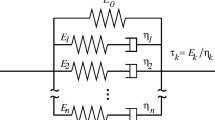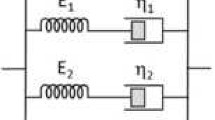Abstract
Standard methods for deriving relaxation data from measurements invariably involve some form of ramp-type deformation history, the initial portion of which is typically not employed for modulus evaluation. In fact, the “ten-times-rule” or a variant thereof is widely used at the expense of short term data acquisition. This paper suggests a simple if (not) obvious method to extend the range of relaxation data that can be acquired from a single test at a single temperature. The method draws on new computational developments for inverting ill-conditioned systems of equations which allows the determination of relaxation parameters nearly routinely and trouble-free. We demonstrate this process for extraction of relaxation characterization from ramp strain histories through (a) numerical evaluation with a virtual test sequence, as well as through (b) data measured in the laboratory. Limitations regarding the time range over which the relaxation modulus can be extracted from laboratory measurements in terms of equipment resolution and stability are discussed. With these constraints in mind it appears feasible to extend the time range by three to four decades towards shorter times when compared with the application of the “ten-times-rule”. Similar treatments apply to the acquisition of creep compliance data.
Similar content being viewed by others
References
Branch, M.A.: A subspace, interior and conjugate gradient method for large-scale bound-constrained minimization problems. SIAM J. Sci. Comput. 21(1), 1–23 (1999)
Clauser, J., Knauss, W.G.: On the numerical determination of relaxation and retardation spectra for linearly viscoelastic materials. Trans. Soc. Rheol. 12(1), 143–153 (1968)
Emri, I., Tschoegl, N.T.: Generating line spectra from experimental responses. Part I: Relaxation modulus and creep compliance. Rheol. Acta 32, 311–321 (1993a)
Emri, I., Tschoegl, N.T.: Generating line spectra from experimental responses. Part II: Storage and Loss functions. Rheol. Acta 32, 322–327 (1993b)
Emri, I., Tschoegl, N.T.: Generating line spectra from experimental responses. Part IV: Application to experimental data. Rheol. Acta 33, 60–70 (1994)
Emri, I., Tschoegl, N.T.: An iterative computer algorithm for generating line spectra from linearly viscoelastic response functions. Int. J. Polym. Mater. 40, 55–79 (1998)
Ferry, J.D.: Viscoelastic Properties of Polymers. Wiley, New York (1948)
Flory, A., McKenna, G.B.: Finite step rate corrections in stress relaxation experiments: A comparison of two methods. Mech. Time Mater. 8, 17–37 (2004)
Kelchner, R.E., Aklonis, J.J.: Measurements of the stress-relaxation modulus in the primary transition region. J. Polym. Sci. A-2 9, 609–614 (1971)
Leaderman, H.: Elastic and Creep Properties of Filamentous Materials and other High Polymers. The Textile Foundation, Washington (1943)
Leaderman, H.: Mechanical Properties of Polymers. H. Leaderman, Washington (no date)
Lee, S., Knauss, W.G.: A note on the determination of the relaxation and creep data from ramp tests. Mech. Time Mater. 4, 1–7 (2000)
Plazek, D.J.: Magnetic bearing torsional creep apparatus. J. Pol. Sci. Part A-2 6, 621–638 (1968)
Sorvari, J., Malinen, M.: Determination of the relaxation modulus of a linearly viscoelastic material. J. Mech. Time-Depend. Mater. 10, 125–133 (2006)
Tobolsky, A.V.: Properties and Structure of Polymers. Wiley, New York (1960)
Tschoegl, N.T., Emri, I.: Generating line spectra from experimental responses. Part III. Interconversion beween relaxation and retardation behavior. Int. J. Polym. Mater. 18, 117–127 (1992)
Author information
Authors and Affiliations
Corresponding author
Rights and permissions
About this article
Cite this article
Knauss, W.G., Zhao, J. Improved relaxation time coverage in ramp-strain histories. Mech Time-Depend Mater 11, 199–216 (2007). https://doi.org/10.1007/s11043-007-9035-4
Received:
Accepted:
Published:
Issue Date:
DOI: https://doi.org/10.1007/s11043-007-9035-4




